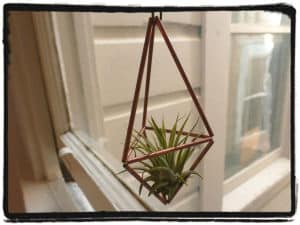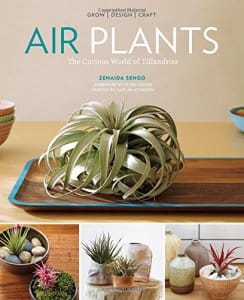 Are you getting into the whole air plant thing? I have a teeny tiny air plant (a.k.a. Tillandsia) that swings like an acrobat on a small metal swing. He goes into a glass of water two times a week for a 15 minute soak and then gets air dried upside down on the counter for several minutes before returning to his perch. Sometimes my epiphytic friend (who natively hails from Latin America and typically lives in the canopy of a tree or on a rock)
Are you getting into the whole air plant thing? I have a teeny tiny air plant (a.k.a. Tillandsia) that swings like an acrobat on a small metal swing. He goes into a glass of water two times a week for a 15 minute soak and then gets air dried upside down on the counter for several minutes before returning to his perch. Sometimes my epiphytic friend (who natively hails from Latin America and typically lives in the canopy of a tree or on a rock)
gets moved around the apartment. Now, in November, the lighting is lower in the sky, so he enjoys front row window seating looking out at the neighbors courtyard. Once spring rolls around, and the sun becomes more intense, he’ll need to be relocated a healthy distance from the window. In a small apartment there aren’t many choices, and fortunately, he’s smaller than my dog’s nose, so he’s not consuming too much space.
About Tillandsias and Epiphytic Plants
 For a house plant, Tillandsias are a good way to have a “green thumb gardening experience”. For gifts, these are easy ones. They tend to be easy to get your hands on in local garden shops. And while I only have one air plant at the moment, I’m thinking about a possible mate to keep him company.
For a house plant, Tillandsias are a good way to have a “green thumb gardening experience”. For gifts, these are easy ones. They tend to be easy to get your hands on in local garden shops. And while I only have one air plant at the moment, I’m thinking about a possible mate to keep him company.
Design Possibilities are Endless!
While many people enjoy the simple-care air plants need. Others take the low care, plus endless design possibilities and create amazing arrangements mounted on walls or suspended from the ceiling.
A newly published book: Air Plants, by Zenaida Sengo, shows just that, and includes stunning photos and ideas for easily decorating with air plants and also has 6 step-by-step projects, including 3 unique terrariums.
Now back to some basics…
Air Plants as House Plants: CARE
Being epiphytes and not terrestrial plants, the roots of air plants serve to anchor them, not to absorb nutrients and water: the leaves do that! Though easy to care for, air plants are living plants are Do Require Care. Three important components to their care are: Air Circulation, Water and Light. Get these right and you’re gonna have a happy plant.
- Water – Air Plants take in water and nutrients through their leaves (specifically the scales on their leaves). A good soaking is recommended two to three times a week. This will vary depending upon whether your home is hot and dry or cool and humid. You can also mist with water, in between, but this method isn’t sufficient as a sole means of watering.
- Light – Bright filtered light is best. My Tillandsia will live directly in front of the window November till March. After that he will move a few feet from the window so that the brighter more intense sun of spring and summer doesn’t cause burning.
- Air Circulation – Make sure that your air plant is not staying moist and wet after soaking.
- Temperature – 50 – 90 degrees F.
Happy Gardening!
![]()
 ps: If you can’t find any Tillandsias at your local garden shops – this is a 5 Pack Assorted Tillandsia Ionantha from Amazon.
ps: If you can’t find any Tillandsias at your local garden shops – this is a 5 Pack Assorted Tillandsia Ionantha from Amazon. (We’re affiliates.) One of them looks similar to the little guy we have – and there are also some others.
